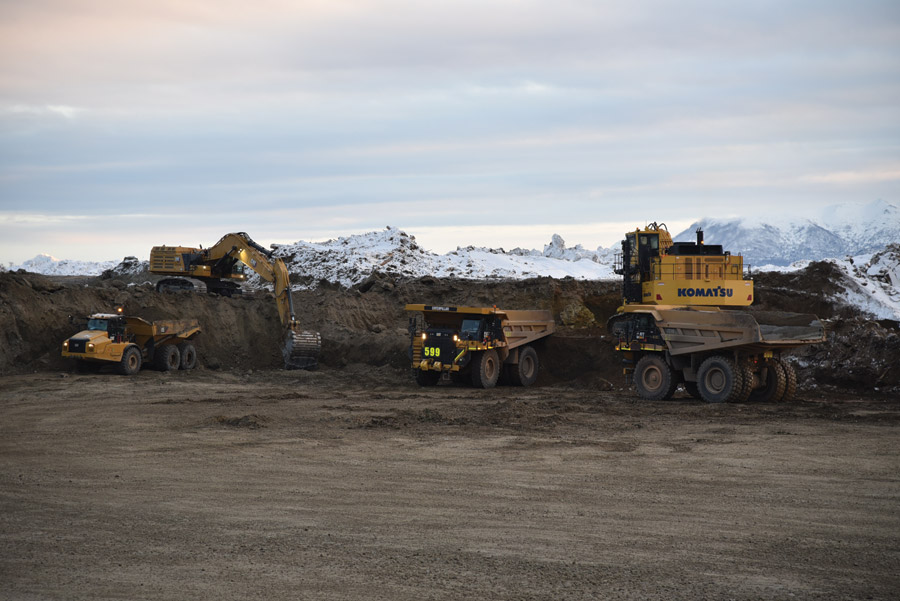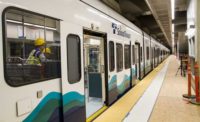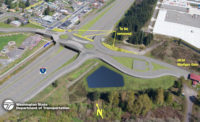Joint Base Elmendorf-Richardson (JBER), north of Anchorage, is a critical link in the security operations in both the Pacific and Arctic regions. As its strategic importance has grown, the U.S. Air Force has wanted to extend the base’s second runway to accommodate the military’s largest aircraft.
There was one big problem blocking the extension of the base’s north-south 16/34 runway: the 12 million cu yd of material at the end of it.
“To extend the runway out, we were going into a small mountain that was already there, a glacial till site,” says Daly Yates, U.S. Army Corps of Engineers project manager for the JBER runway extension.
A $309-million project to extend the runway by 2,900 ft to reach a total length of 10,000 ft launched in November 2022. It was the largest Pacific Air Forces construction project awarded up to that date.
The project is led by the Air Force Installation and Mission Support Center’s Detachment 2 and the Air Force Civil Engineer Center. It is being built in collaboration with the USACE Alaska District, JBER’s 3rd Operations Support and 673rd Civil Engineer Squadrons as well as AFCEC’s Facility Engineering Directorate.
Kiewit Infrastructure serves as the primary contractor with various contracting partners completing an array of tasks, such as excavation, asphalt paving, utility piping, laying of electrical and communication lines and batching and placing concrete.
The sheer volume of excavation is equal to about 800,000 street-legal dump truck loads. If parked end-to-end, that’s enough to stretch from Anchorage to San Antonio, Texas.
“That’s not as the crow flies, that is on the road system,” Yates says. “Imagine the amount of fuel.”
Fortunately for the project, the excavated mountain is being used both by the Air Force as fill on the base and to backfill existing gravel pits to limit hillside drainage concerns. Yates says all the locations are nearby, ensuring the fill doesn’t travel far. Roughly 11 million cu yd has been removed from the site to date.

Extending the runway required removing 12 million cu yd of material.
Photo courtesy U.S. Army Corps of Engineers
Strategic Need
When completed in fall of 2025, the extension will ensure the 10,000 ft length matches that of the existing east-west 06/24 runway and thereby create improved efficiencies and operational options for the strategic base located roughly 3,000 miles from Washington, D.C., 3,000 miles from Europe and 3,000 miles from Asia.
The JBER supports missions that include some of the Air Force’s largest aircraft, such as the C-17 Globemaster IIIs, KC-10 tankers and KC-135 Stratotankers. The runway extension is needed to support these heavier aircraft that require a shallower climb because they can’t gain altitude as quickly as lighter aircraft.
“This has been a long time coming in terms of flexibility and reliability of operations here,” says Col. Jeffrey “L.J.” Rivers, U.S. Air Force operations group commander, adding that at this point upgrading the runway at JBER has become a key strategic focus for national security.
“To extend the runway out, we were going into a small mountain that was already there.”
—Daily Yates Last, Project Manager, U.S. Army Corps of Engineers
With 10,000 ft needed to handle large frame aircraft, JBER had an oversized reliance on the east-west 06/24 runway. That created operational congestion. When 06/24 is closed due to difficult weather, it limits JBER’s capability to project power into the Indo-Pacific region. Lengthening runway 16/34 to match 06/24 will provide full capability for all air frames and optimize mission performance.
“The challenges we have here are primarily weather related,” Rivers says. With the high volume of traffic using the east-west runway, poor weather conditions reduce the ability to move aircraft in and out quickly.
By extending the north-south option, it “creates accessibility” because multiple usable runways will allow the airport to respond to a variety of conditions in Anchorage.
Then there’s improved local operational efficiency. Rivers says a significant number of daily training missions run to the north.
The Anchorage Bowl—areas within the city’s municipal and geographical region—is one of the busiest airspaces in the world. The FAA has an entire section on regulations for the area due to the congestion with aircraft operating through the airspace. JBER flights, commercial flights arriving and departing from Ted Stevens Anchorage International Airport, flights at Lake Hood Seaplane Base (the most active seaplane base in the world) and those at nearby Merrill Field all add traffic to the Anchorage Bowl.
The extended runway will allow military planes to recover and depart to the north and also from the north, eliminating the need to recover and depart within the congested areas to the east and west.

Joint Base Elmendorf-Richardson accommodates some of the military’s largest aircraft, including the C-130J Super Hercules.
Photo courtesy U.S. Army Corps of Engineers
Improving Efficiency
The reduced congestion makes extending the runway a “no brainer,” all while improving efficiency, Rivers says. The base can spend more time on training instead of having to continually clear space for civilian air traffic. Taking off to the north instead of to the east or west is expected to improve operational efficiency up to 9%, which equates to millions of dollars saved each year, ultimately making up the money for the extension.
“The 16/34 runway extension is a real jobs project,” Pat Harrison, Alaska area manager for Kiewit Infrastructure, said in a statement when the project was announced.
The project will also extend the two parallel taxiways, add an arm/disarm pad, upgrade the airfield lighting and the instrument landing system, reroute Airlifter Drive around the north end of the extension, relocate airfield perimeter fencing and reconfigure utility services.
Yates says they’ve already helped stabilize existing roads and constructed a new road for future expansion.
Elmendorf Air Force Base was built roughly 80 years ago during World War II (it was merged with the U.S. Army’s nearby Fort Richardson in 2010.) Yates says that as they move the work inside the current airfield, “we are finding things nobody knows about as we are digging through, encountering different site conditions.” He says it requires the team to remain nimble and devise unique approaches as they handle unforeseen situations.
“It is pretty commendable the things they have found and are working around to keep it on the timeline. It’s pretty impressive.”
—Col. Jeffrey "L.J." Rivers, U.S. Air Force Operations Group Commander
Even the 12 million cu yd of fill is a toned-down figure thanks to engineers working to limit the amount of mountain needed for removal. The key change was instead of keeping the runway at a perfect 0% gradient, which would have required a total of 20 million cu yd of excavation, the team increased the gradient on the addition to the maximum allowed 1% and saved 8 million cu yd of excavation. The existing portion of the runway will remain at the original gradient, while the addition will take on the 1%.
Already the team has had to salvage wetlands to the north and stabilize a lake with a 30-ft-deep, 30-in.-wide and 1,000-ft-long bentonite slurry wall. “That helped us keep the groundwater from flowing out of those lakes to our now lower excavation area,” Yates says.
The harsh Alaska winters have served as a benefit on the year-round project. Yates says the mass excavation moves quicker in the winter when the soil isn’t as wet. To do the work, the team employed seven CAT 777 off-highway trucks, six CAT 657 open-bowl scrapers, eight CAT 745/Volvo 60A articulated haul trucks, two CAT D9 dozers, two CAT D10 dozers, one CAT 395 excavator and one PC2000 surface mining excavator.
Yates notes that “this kind of equipment just doesn’t sit around Alaska,” requiring Kiewit to bring the equipment in on barges and devise a unique route to move the equipment from the port to the base using backroads so as not to destroy public roadway.
When it comes time to build the actual runway, Yates says they will have batch plants on site for several different activities. An asphalt plant, concrete plant and plug mill will do everything from making coarse gravel for the runway base to the needed top layer.
Runway Rebuild
Originally the plan included simply overlaying the existing portion of the runway—which is also shifted 400 ft to the north to meet airfield design requirements—but that all changed. “When we got to the south end of the runway, we experienced quite drastic undulations that wouldn’t be able to be taken care of with a demo and overlay,” Yates says. Instead, crews will demolish and build back the “perfect runway for Air Force operational capacity.” The entire surface will be brand new across the 10,000 ft.
Rivers says that along with the orientation, the upgrade provides “high-fidelity approaches,” and a new instrument landing system offers a “highly modern system and precision approach radar.” The project allows for future expansion at the base that goes with JBER’s position as a location “strategically important for us and our operations.”
The technical work and the final paving and striping become more affected by weather conditions.
“There is no shortage of construction going on, and it is a huge project when you look outside,” Rivers says. “It is being managed very well. It is pretty commendable the things they have found and are working around to keep it on the timeline. It is pretty impressive.”






Post a comment to this article
Report Abusive Comment